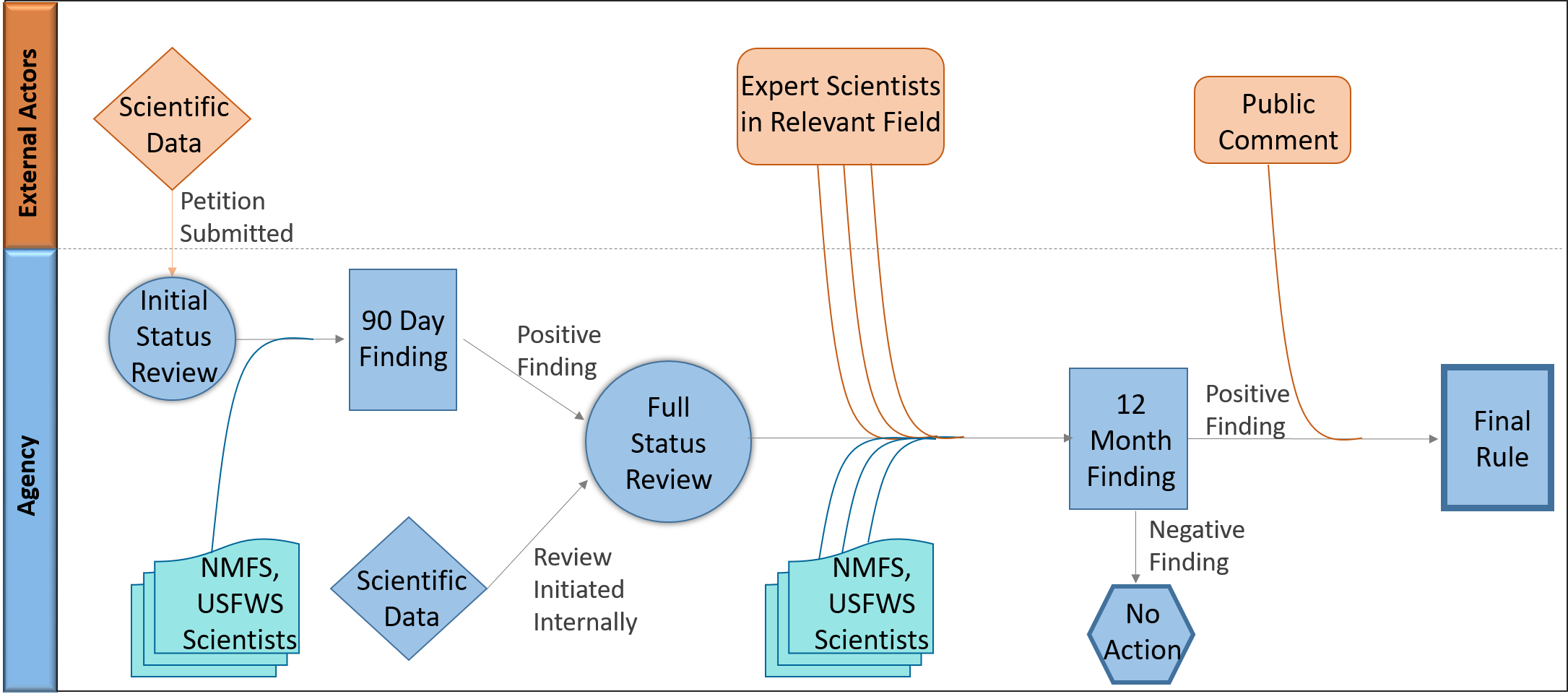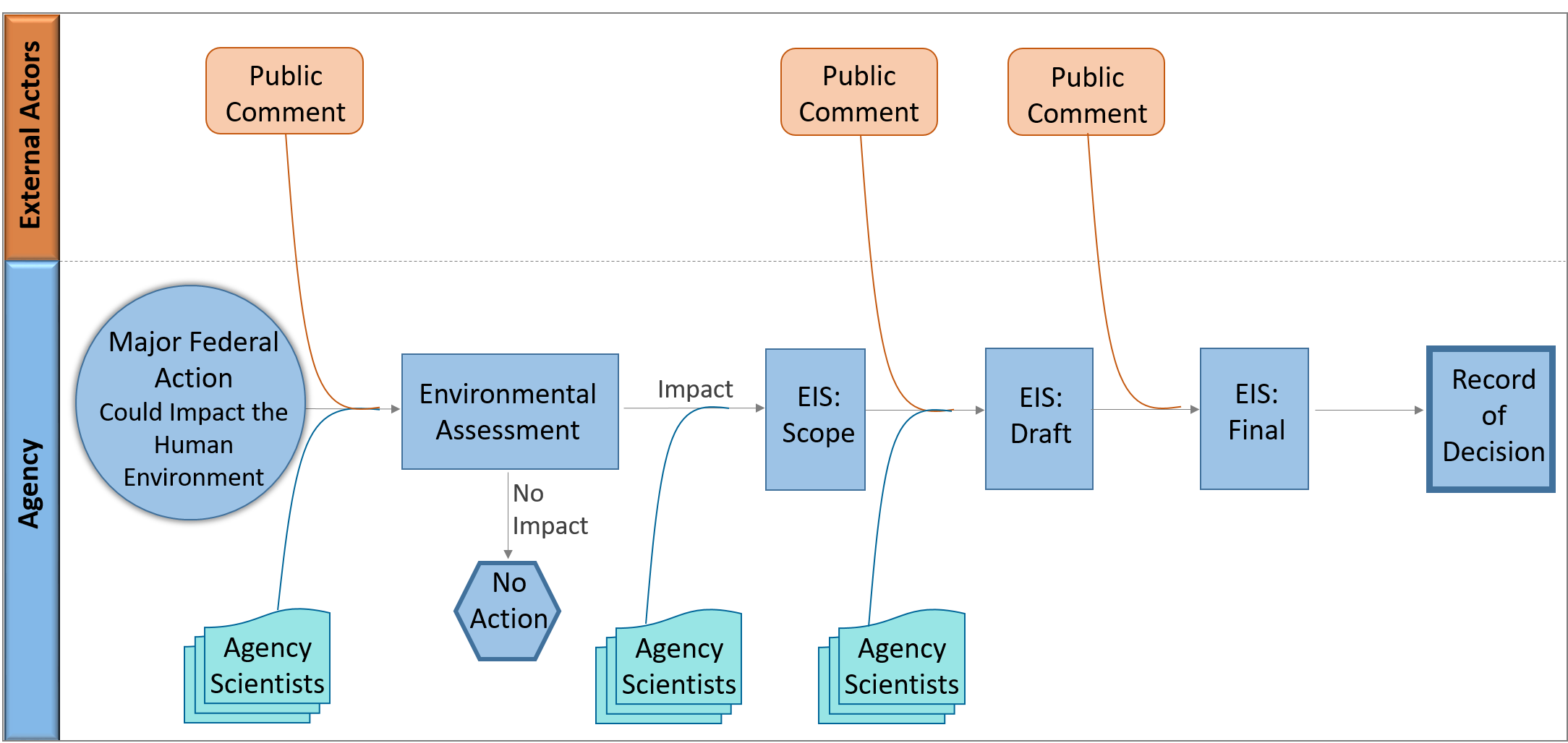Administrative Procedures Act
SUMMARY
Congress passed the Administrative Procedures Act (APA) in 1946 when new agencies were being created and more power was developing within the executive branch. The general purpose is to ensure that the power of the executive branch is not abused. The objectives of the APA include keeping the public informed on agency procedures, making standards for rule-making, and providing for public participation in rule-making. In addition, it defined the grounds for suing an agency that overstepped its bounds. The courts can set aside an agency’s action if they find it “arbitrary and capricious,” meaning the evidence in the administrative record does not support the action. For example, if an agency makes a decision against substantive scientific information provided by public comment without rationalizing that choice, this could provide a legal hook for litigation under the APA. It should be noted, however, that agencies are given a substantial degree of administrative deference, meaning the benefit of the doubt in terms of how to interpret a statute rests with the agency. Nonetheless, the APA is a central foundation to evidence-based policy, and the law that requires public comment, the very focus of this website.
Clean Water Act
AGENCIES
Environmental Protection Agency (EPA)
SUMMARY
The Clean Water Act (CWA) of 1972 is administered by the Environmental Protection Agency. Its purpose is “to restore and maintain the chemical, physical, and biological integrity of the Nation’s waters.” The CWA does so by making it unlawful to discharge into the nation's waters where not permitted. The bulk of CWA implementation is permitting, of which there are two major kinds: a National Pollutant Discharge Elimination System (NPDES) permit for point-source pollutants and a Dredge and Fill permit. The stipulations and exemptions vary by permit type. For example, NPDES permits apply to vessel discharges up to three miles from the coast and non-vessel discharges up to two hundred miles from the shore. And, regular farming, ranching, and silviculture activities are generally exempt from Dredge and Fill permits. Although not regulations, new NPDES and Dredge and Fill permits do trigger public comment in the Federal Register. New NPDES permits also trigger the NEPA process. Lastly, the CWA has a citizen suit provision, which means any individual can bring suit against any person in violation of effluent standards or limitations.
Endangered Species Act
AGENCIES
National Oceanic and Atmospheric Association (NOAA)
US Fish and Wildlife Service (USFWS)
SUMMARY
The purpose of the Endangered Species Act (ESA) of 1973 is to protect and recover imperiled species and the ecosystems on which they depend. The US Fish and Wildlife Service (FWS) and NOAA Fisheries (NOAA) share implementation of the Act; FWS manages terrestrial and freshwater species and NOAA manages marine species. These agencies follow the same regulatory framework for implementing the Act. The major regulations under the ESA are listing, critical habitat designation, and 4(d) protection to extend no "take."
LISTING
For a species to receive protections under the ESA, it must first be listed as threatened or endangered. The agencies can internally initiate status reviews or be petitioned to initiate status reviews to determine whether listing a species is warranted. The agencies respond to petitions through 90-day findings. If the agency publishes a positive finding, it embarks on a full status review and publishes the proposed listing rule as a 12-month finding. After public comment has been incorporated, the agency publishes a final rule.

CRITICAL HABITAT
The agency may designate critical habitat for listed species, usually about a year after publishing the final rule. Unlike listing, economic concerns play a central role in critical habitat designation.
4(D) PROTECTION
Species listed as endangered are automatically protected under "take" prohibitions. To "take" is defined in the Act as to "harass, harm, pursue, hunt, shoot, wound, kill, trap, capture, or collect, or to attempt to engage in any such conduct." Species listed as threatened are not included under the "take" prohibition; the agency must issue protective regulations under section 4(d) of the Act to extend "take" prohibitions to threatened species. The agencies solicit public comment for 4(d) regulations.
Magnuson-Stevens Act
AGENCIES
National Oceanic and Atmospheric Association (NOAA)
SUMMARY
The Magnuson-Stevens Fishery Conservation and Management Act (MSA) of 1976 is administered by NOAA Fisheries. Its purpose is to promote the nation’s fishing industry and its sustainability. The Act applies to federal fisheries in the exclusive economic zone.
REGIONAL COUNCILS
MSA implementation is unique in that the bulk of implementation is overseen by regional councils, with voting and non-voting members. Voting members include representatives from state and federal agencies of that region and citizens nominated by the Council and appointed by the Secretary of Commerce, generally industry representatives. Non-voting members of the Council include representatives of the Coast Guard, State Department, and US Fish and Wildlife Service. Councils determine which fisheries in the region require “conservation and management,” which means those that receive federal regulation under the Act.
FISHERY MANAGEMENT PLANS
For fisheries managed under the MSA, the Council produces a Fishery Management Plan (FMP) through a complex system of fielding public comment and including expert advice from both a scientific and statistical committee and a fishing industry advisory committee. FMPs must be consistent with the MSA’s National Standards, which include but are not limited to preventing overfishing, using the best available science, equity of allocation across states, ensuring safety at sea, and minimizing bycatch. Any changes to existing fishery management plans take the form of amendments. NOAA Fisheries then reviews a FMP or amendment and solicits public comment before a final regulation is issued.
Marine Mammal Protection Act
AGENCIES
National Oceanic and Atmospheric Association (NOAA)
US Fish and Wildlife Service (USFWS)
SUMMARY
The Marine Mammal Protection Act (MMPA) of 1972 is administered by NOAA Fisheries and the US Fish and Wildlife Service (FWS), and its purpose is to conserve marine mammals. It was passed during a time of growing public concern over the health of marine mammal populations and the marine environment generally. The bulk of implementation functions through prohibition of “take” of marine mammals without permits, assessment of population status, and development of conservation plans..
INCIDENTAL TAKE PERMITS
Similar to the Endangered Species Act, “take” includes to hunt, harass, capture, or kill. Incidental Take Permits are required for actions that may cause incidental but not unexpected take, such as sonar activities from military or oil and gas exploration. Commercial fisheries are not required to seek these permits, as it is managed separately under the Marine Mammal Authorization Program. Incidental Take Permits require public comment in the Federal Register and additionally trigger the NEPA process.
STOCK ASSESSMENT REPORTS
The MMPA also requires NOAA Fisheries and the FWS to produce stock assessment reports of marine mammals in federal waters, by using the “best available science.” These reports are used to assess population status and effects of anthropogenic activities, authorize “take,” design appropriate conservation measures, and evaluate fishery management actions to reduce incidental take of marine mammals. The agencies are required to solicit public comment in the development of these reports. If a stock assessment report finds a population to be “depleted,” based solely on the “best available science,” then the agency must make this decision through a regulation with public comment.
CONSERVATION PLANS
When a stock is declared depleted, the agency must produce a Conservation Plan so long as the plan could promote the conservation of the stock. The goal of Conservation Plans is to restore the stock to the optimum sustainable population, modeled after recovery plans under the Endangered Species Act.
National Environmental Policy Act
SUMMARY
The National Environmental Policy Act (NEPA) of 1969 requires federal agencies to consider the environmental impacts of major federal actions and to develop alternatives before taking the action. In addition, it requires disclosure of the environmental impacts to the public and solicitation for public comment on proposed actions. NEPA is a procedural statute, meaning it does not prescribe a particular result. Instead, it prescribes the process for incorporating and considering information pertaining to environmental impacts in decision-making.
OVERVIEW OF PROCESS

ENVIRONMENTAL ASSESSMENT
Any major federal action that could have an effect on the quality of the human environment triggers the NEPA process and agencies must complete the process prior to committing themselves to a course of action. The process begins with the production of the Environmental Assessment (EA) and public involvement, although the agency has deference in terms of defining how this involvement takes shape.
ENVIRONMENTAL IMPACT STATEMENT
The EA will trigger a full Environmental Impact Statement (EIS) if there is a chance of the action causing significant harm to the environment, otherwise the EA ends in a Finding of No Significant Impact (FONSI). The EIS must include the environmental impacts of the action, a list of alternative actions, and the impacts of those alternatives. Impacts include direct, indirect, and cumulative. There are four stages to producing an EIS. First, the agency must define the scope of the EIS and solicit public comment through the Federal Register. Second, the agency must publish a draft EIS and solicit a second round of public comment through the Federal Register. Third, an agency must prepare and publish the final EIS and incorporate public comment. The agency then waits for a minimum of 30 days prior to a final decision. Lastly, the agency must issue a Record of Decision describing the alternative action chosen, the alternative with the minimal environmental impact, and if the alternative with the minimal impact was not chosen, the rationale for this decision.
Recent news & Events
UPCOMING EVENTS
PAST EVENTS

February 27, 7pm
Optimism Brewing
Seattle, WA

Graduate Climate Conference
Pack Forest, WA

Public Comment
May 1, 5-7pm
Fremont Branch, Seattle Public Library

Workshop: 4th National Climate Assessment
January 9, 17, 25, 29
UW Seattle, ATG/OSB
